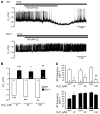Suppression of KATP channel activity protects murine pancreatic beta cells against oxidative stress
- PMID: 19805912
- PMCID: PMC2769178
- DOI: 10.1172/JCI38817
Suppression of KATP channel activity protects murine pancreatic beta cells against oxidative stress
Abstract
The enhanced oxidative stress associated with type 2 diabetes mellitus contributes to disease pathogenesis. We previously identified plasma membrane-associated ATP-sensitive K+ (KATP) channels of pancreatic beta cells as targets for oxidants. Here, we examined the effects of genetic and pharmacologic ablation of KATP channels on loss of mouse beta cell function and viability following oxidative stress. Using mice lacking the sulfonylurea receptor type 1 (Sur1) subunit of KATP channels, we found that, compared with insulin secretion by WT islets, insulin secretion by Sur1-/- islets was less susceptible to oxidative stress induced by the oxidant H2O2. This was likely, at least in part, a result of the reduced ability of H2O2 to hyperpolarize plasma membrane potential and reduce cytosolic free Ca2+ concentration ([Ca2+]c) in the Sur1-/- beta cells. Remarkably, Sur1-/- beta cells were less prone to apoptosis induced by H2O2 or an NO donor than WT beta cells, despite an enhanced basal rate of apoptosis. This protective effect was attributed to upregulation of the antioxidant enzymes SOD, glutathione peroxidase, and catalase. Upregulation of antioxidant enzymes and reduced sensitivity of Sur1-/- cells to H2O2-induced apoptosis were mimicked by treatment with the sulfonylureas tolbutamide and gliclazide. Enzyme upregulation and protection against oxidant-induced apoptosis were abrogated by agents lowering [Ca2+]c. Sur1-/- mice were less susceptible than WT mice to streptozotocin-induced beta cell destruction and subsequent hyperglycemia and death, which suggests that loss of KATP channel activity may protect against streptozotocin-induced diabetes in vivo.
Figures










Similar articles
-
KATP channel blockers control glucagon secretion by distinct mechanisms: A direct stimulation of α-cells involving a [Ca2+]c rise and an indirect inhibition mediated by somatostatin.Mol Metab. 2021 Nov;53:101268. doi: 10.1016/j.molmet.2021.101268. Epub 2021 Jun 9. Mol Metab. 2021. PMID: 34118477 Free PMC article.
-
Energy depletion and not ROS formation is a crucial step of glucolipotoxicity (GLTx) in pancreatic beta cells.Pflugers Arch. 2018 Mar;470(3):537-547. doi: 10.1007/s00424-017-2094-8. Epub 2017 Dec 7. Pflugers Arch. 2018. PMID: 29218453
-
Loss of β-Cell KATP Reduces Ca2+ Sensitivity of Insulin Secretion and Trpm5 Expression.Diabetes. 2025 Mar 1;74(3):376-383. doi: 10.2337/db24-0650. Diabetes. 2025. PMID: 39666394
-
Role of K(ATP) channels in β-cell resistance to oxidative stress.Diabetes Obes Metab. 2012 Oct;14 Suppl 3:120-8. doi: 10.1111/j.1463-1326.2012.01644.x. Diabetes Obes Metab. 2012. PMID: 22928572 Review.
-
Molecular biology of adenosine triphosphate-sensitive potassium channels.Endocr Rev. 1999 Apr;20(2):101-35. doi: 10.1210/edrv.20.2.0361. Endocr Rev. 1999. PMID: 10204114 Review.
Cited by
-
Bile acids acutely stimulate insulin secretion of mouse β-cells via farnesoid X receptor activation and K(ATP) channel inhibition.Diabetes. 2012 Jun;61(6):1479-89. doi: 10.2337/db11-0815. Epub 2012 Apr 9. Diabetes. 2012. PMID: 22492528 Free PMC article.
-
Mitochondrial succinate dehydrogenase is involved in stimulus-secretion coupling and endogenous ROS formation in murine beta cells.Diabetologia. 2015 Jul;58(7):1532-41. doi: 10.1007/s00125-015-3577-9. Epub 2015 Apr 15. Diabetologia. 2015. PMID: 25874444
-
The Role of ABC Transporters in Skin Cells Exposed to UV Radiation.Int J Mol Sci. 2022 Dec 21;24(1):115. doi: 10.3390/ijms24010115. Int J Mol Sci. 2022. PMID: 36613554 Free PMC article. Review.
-
ATP-Sensitive Potassium Channels in Migraine: Translational Findings and Therapeutic Potential.Cells. 2022 Aug 4;11(15):2406. doi: 10.3390/cells11152406. Cells. 2022. PMID: 35954249 Free PMC article. Review.
-
Effect of Diazoxide Preconditioning on Cultured Rat Myocardium Microvascular Endothelial Cells against Apoptosis and Relation of PI3K/Akt Pathway.Balkan Med J. 2014 Mar;31(1):83-7. doi: 10.5152/balkanmedj.2013.8458. Epub 2014 Mar 1. Balkan Med J. 2014. PMID: 25207174 Free PMC article.
References
MeSH terms
Substances
LinkOut - more resources
Full Text Sources
Molecular Biology Databases
Miscellaneous

